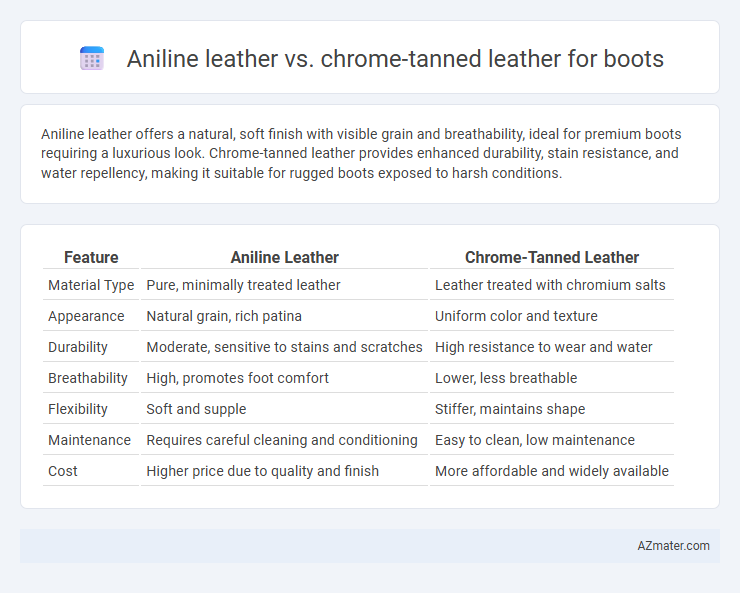Aniline leather offers a natural, soft finish with visible grain and breathability, ideal for premium boots requiring a luxurious look. Chrome-tanned leather provides enhanced durability, stain resistance, and water repellency, making it suitable for rugged boots exposed to harsh conditions.
Table of Comparison
| Feature | Aniline Leather | Chrome-Tanned Leather |
|---|---|---|
| Material Type | Pure, minimally treated leather | Leather treated with chromium salts |
| Appearance | Natural grain, rich patina | Uniform color and texture |
| Durability | Moderate, sensitive to stains and scratches | High resistance to wear and water |
| Breathability | High, promotes foot comfort | Lower, less breathable |
| Flexibility | Soft and supple | Stiffer, maintains shape |
| Maintenance | Requires careful cleaning and conditioning | Easy to clean, low maintenance |
| Cost | Higher price due to quality and finish | More affordable and widely available |
Introduction to Aniline and Chrome-Tanned Leather
Aniline leather is characterized by its natural, porous surface treated with transparent dyes that highlight the hide's unique grain and marks, offering a soft, breathable texture ideal for premium boots. Chrome-tanned leather undergoes a chemical tanning process using chromium salts, providing enhanced durability, water resistance, and colorfastness, which are essential for rugged, long-lasting footwear. Both types cater to different boot preferences, with aniline leather prized for its aesthetic appeal and chrome-tanned leather favored for performance and protection.
What is Aniline Leather?
Aniline leather is a type of natural hide dyed exclusively with soluble dyes, preserving the leather's original surface and grain characteristics, which offers a soft, supple texture ideal for high-quality boots. Unlike chrome-tanned leather, which undergoes treatment with chromium salts to enhance durability and water resistance, aniline leather is more breathable but less resistant to stains and scratches. Choosing aniline leather for boots provides a premium, natural look with visible markings and a rich patina that develops uniquely over time.
Understanding Chrome-Tanned Leather
Chrome-tanned leather is treated with chromium salts, resulting in a durable, water-resistant material frequently used in boot manufacturing. This tanning process preserves the leather's softness while enhancing its strength and color retention compared to aniline leather, which retains the natural surface. Boots made from chrome-tanned leather offer superior protection against wear, stains, and environmental damage, making them ideal for rugged, everyday use.
Tanning Processes: Aniline vs Chrome
Aniline leather is processed using natural tannins that preserve the hide's original texture and grain, resulting in a soft, breathable material ideal for high-quality boots. Chrome-tanned leather undergoes treatment with chromium salts, producing a more water-resistant and durable finish that resists wear and stiffening. The aniline tanning process enhances the leather's natural look but requires careful maintenance, while chrome tanning offers a robust, colorfast boot with greater resistance to environmental damage.
Appearance and Texture Comparison
Aniline leather exhibits a natural, rich appearance with visible grain and unique markings, offering a soft, supple texture ideal for high-end boots. Chrome-tanned leather features a more uniform color and smoother surface due to chemical tanning, providing durability and water resistance while sacrificing some natural character. The choice between aniline and chrome-tanned leather impacts the boot's aesthetic appeal and tactile experience, with aniline emphasizing organic beauty and chrome-tanned focusing on consistency and robustness.
Durability and Longevity
Aniline leather boots, crafted with minimal surface coatings, showcase a natural appearance but generally have lower durability and are more prone to scratches and stains compared to chrome-tanned leather. Chrome-tanned leather boots benefit from chemical tanning processes, enhancing water resistance, flexibility, and long-term strength, making them more suitable for heavy-duty use and extended wear. For longevity and rugged durability, chrome-tanned leather boots provide superior performance, especially in demanding outdoor environments.
Comfort and Wearability Factors
Aniline leather offers exceptional breathability and softness due to its minimal surface coating, making it highly comfortable and adaptable to foot shape over time. In contrast, chrome-tanned leather provides enhanced durability and water resistance but may feel stiffer initially, requiring a longer break-in period for optimal wearability. Boot wearers prioritizing immediate comfort often prefer aniline leather, while those seeking longevity and protection opt for chrome-tanned variants.
Maintenance and Care Requirements
Aniline leather requires careful maintenance with regular use of pH-neutral leather cleaners and conditioners to preserve its natural, breathable surface and prevent staining. Chrome-tanned leather is more resistant to water and wear, allowing easier cleaning with mild soap and water, making it a practical choice for rugged boot usage. Both types benefit from prompt removal of dirt and moisture, but aniline leather needs extra protection against UV exposure and oils to maintain its rich, natural appearance.
Environmental Impact and Sustainability
Aniline leather is prized for its minimal processing, using fewer chemical treatments that reduce environmental pollution compared to chrome-tanned leather, which relies heavily on chromium salts known for their toxicity and difficult waste management. The vegetable-based tannins in aniline leather promote biodegradability and lower ecological footprint, supporting sustainable leather production and reducing harmful soil and water contamination. In boot manufacturing, choosing aniline leather contributes to eco-conscious practices by minimizing hazardous chemicals and promoting responsible resource use.
Which is Better for Boots?
Aniline leather, prized for its natural look and breathable surface, offers a soft, supple feel ideal for luxury boots but requires careful maintenance due to its vulnerability to stains and scratches. Chrome-tanned leather provides superior durability, water resistance, and color consistency, making it more practical for heavy-duty boots exposed to harsh conditions. For everyday or outdoor boots, chrome-tanned leather is better suited, while aniline leather excels in fashion-forward, high-end boot designs where aesthetics are prioritized.

Infographic: Aniline leather vs Chrome-tanned leather for Boot
 azmater.com
azmater.com